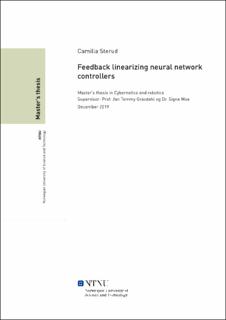| dc.description.abstract | Når reguleringssystemer anvendes i praksis er ukjent og umodellert dynamikk et tilbakevendende problem. Ved anvendelse av avanserte reguleringstekniske metoder, som modellbasert prediktiv og tilbakekoblingslineariserende regulering, antas det at matematiske modeller av systemdynamikken er tilgjengelig, og at de tilnærmer det virkelige systemet så godt at modelleringsfeilen er neglisjerbar, eller i det minste begrenset. Dette er imidlertid ikke alltid tilfellet, og man tar isteden til takke med forenklede reguleringssystemer på bekostning av optimal ytelse.
For tiden finnes det store interesser for å kombinere teoriene fra tradisjonell reguleringsteknikk og datadrevne metoder. Spesielt synes feltet maskinlæring, og dets underordnede felt dyp læring, å ha mye å tilby reguleringsteknikken. Problemet med å inkludere metoder fra dyp læring i reguleringssystemer er at systemet blir mindre gjennomskuelig. Dyp læring handler i hovedsak om nevrale nettverk som er vanskelige å analysere matematisk siden de er store, ugjennomskuelige, ulineære modeller. Reguleringssystemer med maskinlæringskomponenter mangler ofte stabilitetsbevis og garantier for sin oppførsel. Dette er uakseptabelt hvis de skal anvendes i situasjoner hvor sikkerhet er sentralt.
I denne oppgaven utformes en tilbakekoblingslineariserende (feedback linearizing) regulator som bruker et nevralt nettverk til å estimere ukjent dynamikk. Regulatoren har som formål å løse et generelt stifølgingsproblem for en omfattende klasse todimensjonale systemer. Det bevises at regulatoren stabiliserer den lukkede sløyfen, slik at den er pådrag-til-tilstand-stabil (input-to-state stable) og endelig-forsterket Lp-stabil (finite-gain Lp-stable) fra det nevrale nettverkets estimeringsfeil til avviket i stifølgingsproblemet. Videre bevises at regulatoren får avviket til å konvergere eksponentielt og globalt mot en ball sentrert i origo. Konvergensgrensene avhenger av Lipschitzkonstanten til det nevrale nettverket når nettverksestimatet oppdateres sjeldent, eller når tilstandsmålingene påvirkes av støy av begrenset størrelse.
Eksperimenter utføres på et simulert masse-fjær-dempersystem for å undersøke holdbarheten til de teoretiske resultatene, både når systemets dynamikk er uforsinket og når den er tidsforsinket. Når dynamikken er tidsforsinket brukes nevrale konvulsjonsnettverk til å estimere den ukjente dynamikken. En metode for å estimere Lipschitzkonstanten til nevrale forovernettverk utvides til å fungere for nevrale konvulsjonsnettverk.
I eksperimentene utkonkurrerer alle de foreslåtte regulatorene en tilbakekoblingsregulator som ikke kompenserer for den ukjente dynamikken. Når dynamikken er uforsinket finnes det et forhold mellom størrelsen på Lipschitzkonstanten til den nevrale nettverket og regulatorens evne til å undertrykke målestøy. Det finnes også en kobling mellom Lipschitzkonstanten og endringen i regulatorens ytelse når estimatet fra det nevrale nettverket oppdateres sjeldnere. | |
| dc.description.abstract | Unknown and unmodeled dynamics is a reoccurring topic in the practical application of control systems. When using popular control methods such as model predictive control and feedback linearization, it is assumed that an analytical model of the system dynamics is available and that the model is so accurate that the modeling error is negligible, or at the very least bounded. However, this is not always the case, and often the control system is simplified at the expense of optimal performance.
Currently, there is a push to unify the frameworks of traditional control theory and data-driven modeling. In particular machine learning, and its subfield deep learning, seems to have much to offer the field of control theory. The problem with including deep learning methods in control systems is the resulting loss of transparency. Deep learning is mostly concerned with neural networks, which are vast black-box models that are hard to analyze mathematically. Control systems with machine learning in the loop often lack stability proofs and performance guarantees, which are crucial if they are applied in safety-critical situations.
In this thesis, a feedback linearizing controller, which uses a neural network to estimate unknown dynamics, is suggested. The suggested controller is designed for solving a general trajectory tracking problem for a broad class of two dimensional nonlinear systems. The controller is proven to stabilize the closed-loop system, such that it is input-to-state and finite-gain Lp-stable from the neural network estimation error to the tracking error. Further, the controller is proven to make the tracking error globally and exponentially converge to a ball centered at the origin. The convergence bound is shown to be dependent on the Lipschitz constant of the neural network estimator when the estimate is updated discretely, or the state measurements are affected by bounded noise.
Through experiments on a simulated mass-spring-damper system, the validity of the theoretical results is investigated, for when the system dynamics are undelayed and also when they are time-delayed. In the time-delayed case, convolutional neural networks are used to estimate unknown dynamics. A procedure for estimating the Lipschitz constant of feedforward networks is therefore extended to work for convolutional neural networks.
In the experiments, all tested controllers outperform a feedback controller that does not compensate for unknown dynamics. When the dynamics are undelayed, there is a relationship between the size of the Lipschitz constant of the neural network and a controller's ability to reject noise. There is also a connection between the Lipschitz constant and the change in performance when the update frequency of the neural network estimate declines. | |
